peaq represents a multi-chain Layer 1 blockchain engineered to optimize Decentralized Physical Infrastructure Networks (DePIN). Its architecture facilitates scalability beyond 10,000 transactions per second (TPS) while maintaining a notably low transaction cost of approximately $0.00025.
peaq prioritizes environmental sustainability within its blockchain framework and leverages the extensive developer ecosystems of Ethereum, the largest, and Polkadot, the second-largest, within Web3.
1. Product
1.1. Overview
peaq offers a versatile toolkit for developers by supporting EVM and ink! (Rust) Smart Contracts and Pallets.
It provides a wide range of backend functionalities that are crucial for DePINs and dApps. These include features like self-sovereign Machine IDs, role-based access control, seamless machine payment processing, machine data storage, Machine NFTs, data indexing, autonomous AI agents, and more. Developers can utilize the peaq SDK in JavaScript to access Rust-based functions, simplifying tasks such as assigning identities to machines, robots, and devices with just a concise codebase of 15 lines.
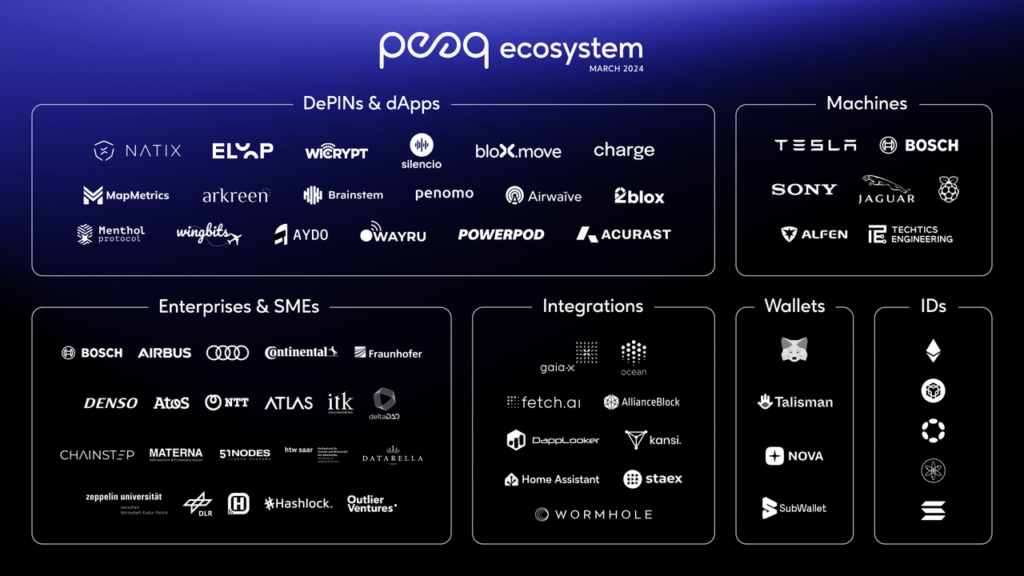
1.2. USP
peaq’s ability to operate across multiple chains allows for smooth integration with Polkadot, enables the establishment of cross-chain machine identities with Cosmos, and establishes connections to Ethereum through bridges. The platform operates based on an economic model that is tailor-made to provide incentives to both users and machines participating in the Economy of Things. This model rewards active engagement, contributions, and transaction-driving actions by machines and developers, creating an ecosystem that is dynamic, mutually beneficial, and highly engaged.

- Easy to deploy: peaq Network supports Rust, EVM smart contracts, and pallet, providing developers with flexibility and convenience. peaq offers a range of readily available modular DePIN functions to equip DePIN and dApps with essential core features, including server ID, access control, data verification, seamless payment processing, data storage, data indexing, autonomous AI agents, etc. These functions are accessible through the peaq SDK in JavaScript, allowing developers to implement them with just 15 lines of code.
- Cross-chain: peaq Network enables seamless interaction with Polkadot, cross-chain machine ID with Cosmos, Solana, and Binance, as well as connectivity with Ethereum. peaq is compatible with EVM and connected to more than 30 blockchains through Wormhole. peaq rewards machines and DePIN building tools for connecting, contributing, and generating transactions on the network.
- Decentralization: peaq has a Nakamoto coefficient of 90+, the highest among layer 1 and layer 0 blockchains.
- Superior scalability: peaq will scale to over 100,000 transactions per second by leveraging Elastic Scaling and Agile Core Time.
- Environmentally friendly: The peaq network is designed with the most environmentally friendly blockchain architecture on Web3.
- Modular DePIN functionality: peaq provides modular functions ready for use in powering and encrypting assets, robots, and devices on any DePIN.
2. Traction
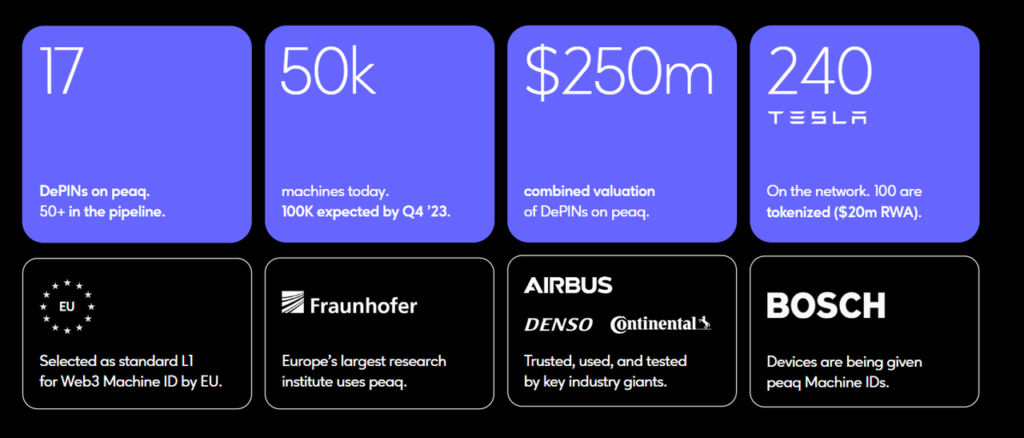
Due to its strong capabilities and extensive features, peaq is experiencing rapid growth and gaining significant recognition in the industry.
At present, the peaq network hosts 17 active DePINs, and an additional 50 DePINs are currently in various stages of development. Supporting this infrastructure are over 50,000 machines, and projections indicate that this number will double by the next year. The combined value of DePINs currently operating on the peaq network is an impressive $250 million, highlighting the network’s increasing importance in the market. The continuous expansion of DePINs and machine participation demonstrates the industry’s growing confidence and adoption of peaq’s offerings. This substantial growth trajectory indicates a promising future for peaq as a prominent player in the decentralized infrastructure landscape.
3. Token
- $PEAQ Token: This is the native token on the peaq mainnet, represented by the symbol $PEAQ.
- $KREST Token: Specifically designed for peaq’s canary network, $KREST operates as its dedicated token.
- $AGUNG Token: Operating as the token on peaq’s testnet, $AGUNG tokens are solely intended for development and testing on the AGUNG platform. These tokens are free and can be freely obtained for testing purposes.
Currently, the project is undergoing development and has not yet made any public announcements regarding the token.
3.1. Token Metric
- Token name: peaq token
- Ticker: $PEAQ
- Blockchain: Updating…
- Contract: Updating…
- Token standard: ERC20
- Total Supply: Updating…
- Circulating Supply: Updating…
3.2. Token Allocation
Updating…
3.3. Vesting Schedule
Updating…
3.4. Token Utility
- Transaction fee
- Governance
- Staking
4. Team & Backers
4.1. Team

- CEO, Founder – Till Wendler
- CTO, CPO, Co-Founder – Leonard Dorlochter
- CMO – Co-Founder – Max Thake
The founders take pride in their deep knowledge and experience in the Internet of Things (IoT) field, which enhances their abilities. Their extensive skill set and well-established backgrounds provide a strong basis for the project.
4.2. Backers
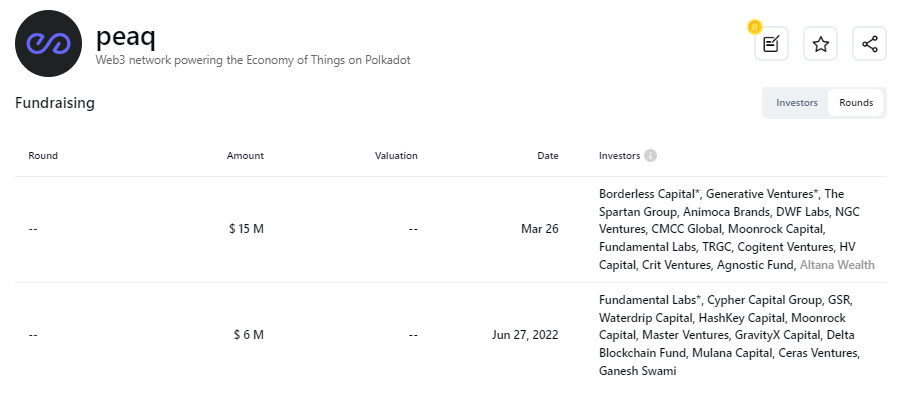
peaq raised $15 million in a multi-tranche funding round to expand its ecosystem of decentralized physical infrastructure (DePIN) networks. The funding round, led by Generative Ventures and Borderless Capital and featuring participation from Spartan Group, Haskey Capital, CMCC Global and Animoca Brands, comes ahead of blockchain’s mainnet launch and listing of the $PEAQ token.
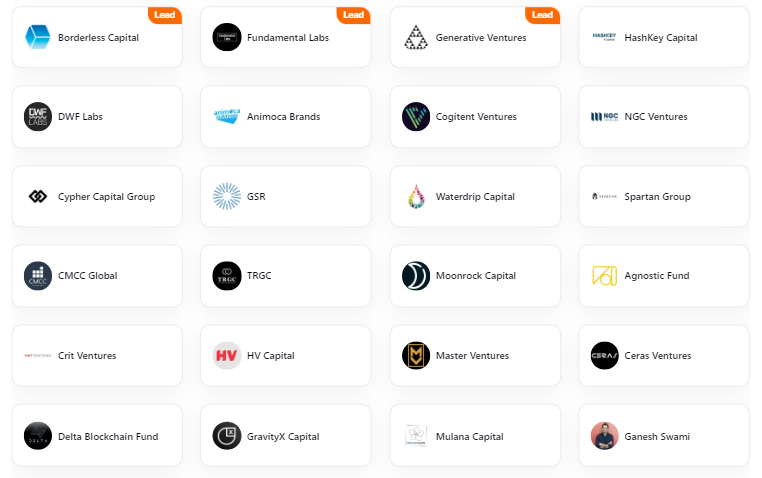
5. Projects link
- Website: https://www.peaq.network/
- Discord: https://discord.com/invite/peaqnetwork
- X/ Twitter: https://twitter.com/peaqnetwork
- Youtube: https://www.youtube.com/channel/UCQwWWkS0EqKjq3RKT6r3pQA
The information provided in this article is for reference only and should not be taken as investment advice. All investment decisions should be based on thorough research and personal evaluation.


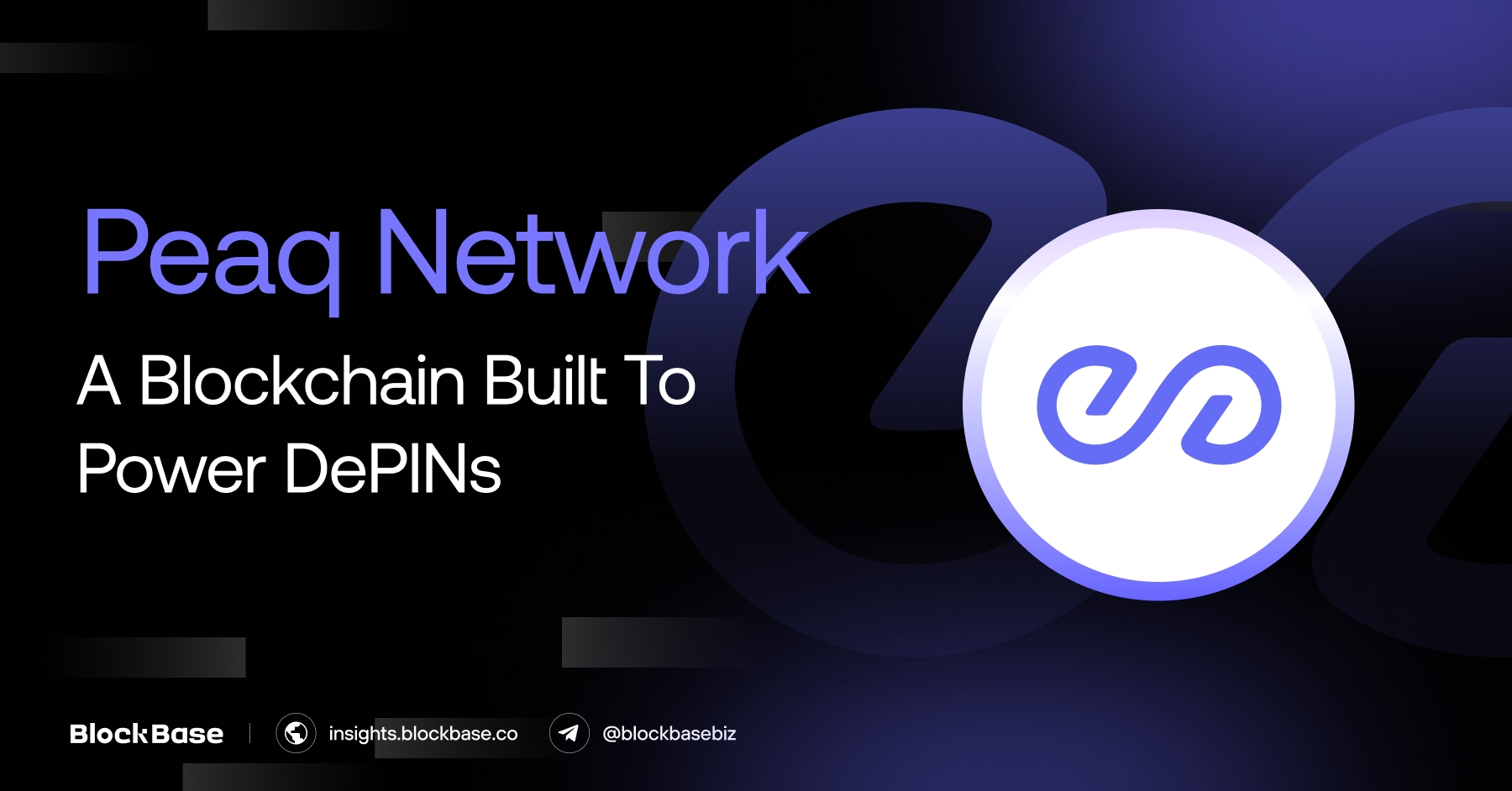



[…] Layer-1 blockchain has low transaction costs, around $0.00025 per transaction. This is a big advantage for scalable […]
Comments are closed.